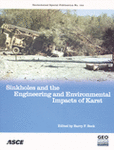A Case Study of the Samanalawewa Reservoir on the Walawe River in an Area of Karst in Sri Lanka
Publication: Sinkholes and the Engineering and Environmental Impacts of Karst
Abstract
The Samanalawewa reservoir, formed by a 100m high embankment dam, is one of the largest reservoirs in Sri Lanka built in the recent times. It is located 160km south east of the capitol, Colombo, and is the key element of the 120-million-watt Samanalawewa Hydroelectric Project. It is constructed on one of the main rivers in Sri Lanka, the Walawe River. Geologically the project is in an area of karst within the Highland series of the Sri Lankan Precambrian complex comprised of crystalline metamorphic rocks. The area has been subjected to extensive folding, faulting and hydrothermal reactions. Thus, the project area is geologically complex. On several occasions a number of agencies have studied the project site, conducting various detailed geological, hydrogeological and geophysical investigations. Signs of a possible leak through the right bank appeared when poor geologic conditions were encountered during construction of the dam. Immediately, more investigations were carried out. During the initial trial impoundment, a small spring appeared downstream of the partially filled reservoir, and impoundment was suspended. Additionally, up to a distance of 2.5 km on the right bank, a flat water table was observed responding to the river levels. As a remedial measure, a 100m-deep, 1300m-long grout curtain was constructed, using 13,640 tons of cement, and impoundment resumed. The leakage continued, increased and finally resulted in a land slide. Impoundment was again suspended, and more detailed investigations were called for. The next remediation effort consisted of installing a liner of clay over the suspected ingress zones. Even after using 50,000m3 of clay, the leakage could not be stopped, although it did help to reduce groundwater pressure in the right bank. The reservoir is presently operating with a continuous leakage of 1800 litres per second. Recently, a number of sinkholes were found in an area far from the areas under consideration. Preliminary studies indicate a connection between these sinkholes and the main leakage. Detailed studies are underway to investigate the extent of the ingress areas as an aid in planning suitable remedial measures. Because of the complex geological conditions caused by karst in the area of the site, the exact mechanism of leakage cannot be established, preventing successful remediation.
Get full access to this chapter
View all available purchase options and get full access to this chapter.
Information & Authors
Information
Published In
Copyright
© 2005 American Society of Civil Engineers.
History
Published online: Apr 26, 2012
Authors
Metrics & Citations
Metrics
Citations
Download citation
If you have the appropriate software installed, you can download article citation data to the citation manager of your choice. Simply select your manager software from the list below and click Download.
